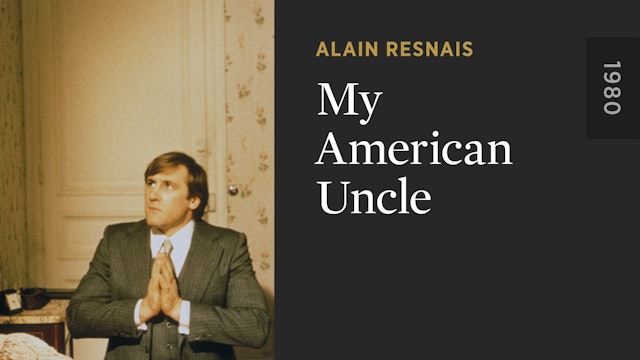Alain Resnais’s Unexpected (and Unjustly Neglected) Art-House Hit

Some twenty years into his feature-film career, Alain Resnais had his first bona fide French commercial success in 1980 with My American Uncle. Also a hit in the U.S., it even went on to receive an Academy Award nomination for Jean Gruault’s screenplay (he lost to Bo Goldman for Melvin and Howard). And yet, unaccountably, like its almost-as-good English-language predecessor Providence (1977), My American Uncle has been largely forgotten—it’s long been out of print on DVD.
Why, in the U.S. at any rate, do Resnais’s landmark 1960s films and the six pleasing, easy-viewing romantic comedies that constitute the third phase of his career, from 1997 to 2014, continue to overshadow his underrated and adventurous (if at times baffling) eight films from 1974 to 1993? To be sure, Resnais’s output slowed during these years, and his kind of cinema was eclipsed in the U.S. by the emergence of a new generation of French filmmakers. The most notable film lost in the mix is Resnais’s little-seen diptych Smoking/No Smoking (1993), a transitional work that initiated the lightly playful, Anglophile direction he would subsequently take, and whose stateside release fell apart for reasons unclear. The film-historical importance of Hiroshima mon amour and Last Year at Marienbad casts a long shadow, and if the late works are charming and relatively frivolous, films like Providence and My American Uncle would appear to land on some uneasy middle ground. They are not as “heavy” or “difficult” as the films of the first phase of Resnais’s career and not as “light” as the films from his third phase. In particular, as an English-language art film with an all-star cast—Dirk Bogarde, John Gielgud, Ellen Burstyn, David Warner—Providence to many doesn’t sound like the kind of film Resnais (or anyone else) would or should have any business making in those days.
But My American Uncle is a different kettle of fish. Both appealing and complex, situated squarely in the mainstream of French art cinema, and featuring freshly minted star Gérard Depardieu, it’s one of Resnais’s best films, representing at once a high-water mark and the most down-to-earth of his exhilarating engagements with modernist aesthetics. So it’s all the more puzzling that this of all his films has been left behind.
Among the experiential baggage that each character carries through life is an internalized, idealized notion of personhood, embodied by a favorite movie star: for Jean, it’s Danielle Darrieux; for Janine, Jean Marais; and for René, Jean Gabin. Over the course of the film, from time to time Resnais cuts to black-and-white clips of these actors, caught in moments that in some way accord with each respective character’s immediate sense of self, particularly in moments of crisis or decision—as if summoned by their psyches.
Possibly these stars loom large in Resnais’s nostalgia for a now-distant era of French cinema—and after all, the push and pull of memory is a central aspect of his work, no less so than here. Resnais initially intended to incorporate a much more extensive selection of clips, which would have likely tilted the film in a more radical direction, but licensing rights proved prohibitively expensive. The role of stardom in Rensais’s filmmaking evolved in a curious manner. In the first two decades of his career he generally took care to cast major stars, from Delphine Seyrig to Yves Montand to Jean-Paul Belmondo. After My American Uncle, however, he withdrew to a stock company of mid-range stars, familiar in France but less so in the U.S., who invariably appeared in every film he made over the next thirty years. His life partner, Sabine Azéma, was the constant around which his last ten films would revolve.






